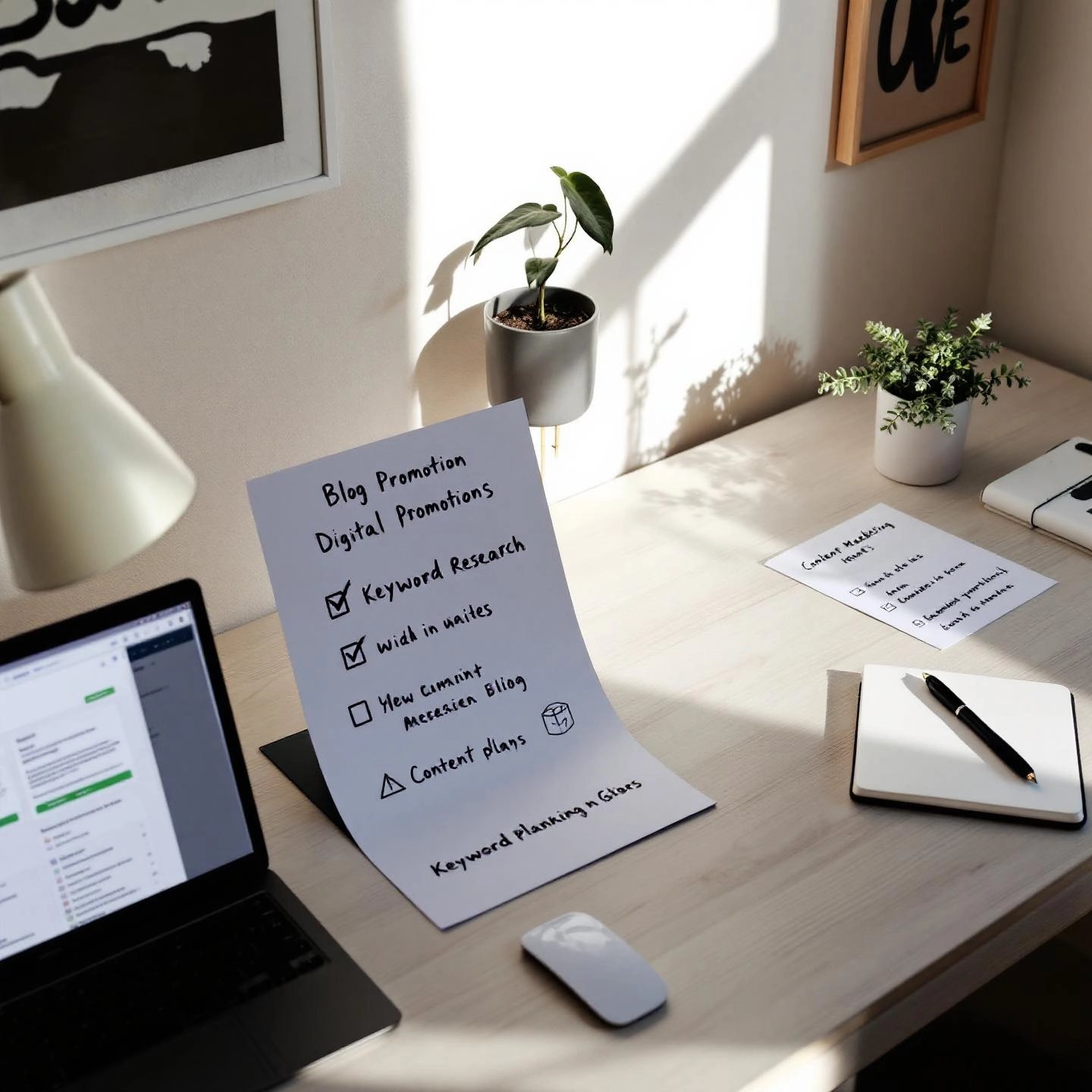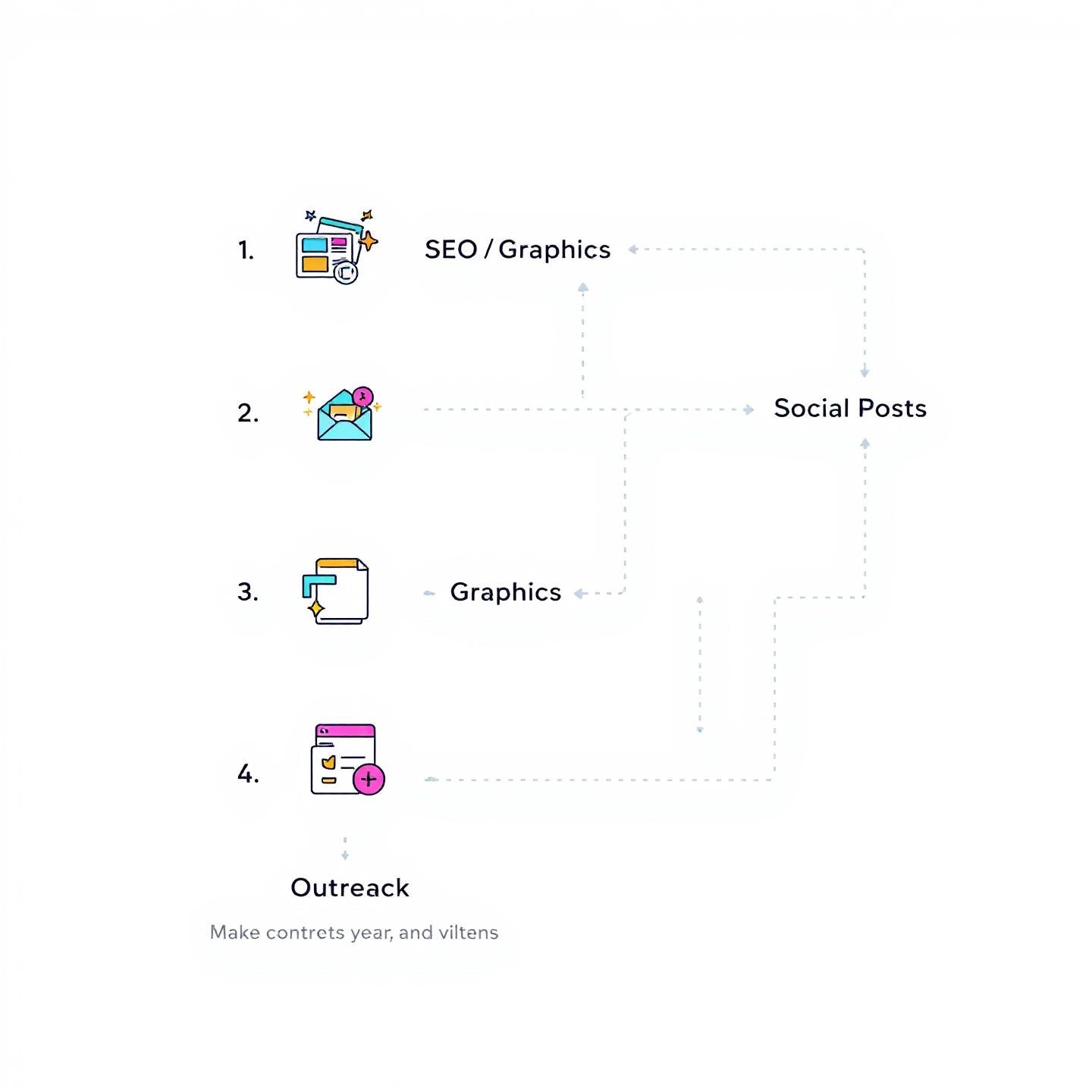Introduction to How to Promote a Blog
Imagine pouring hours into crafting a blog post—researching, writing, editing, and polishing every word. You hit publish, and then… nothing. If this sounds familiar, you’re not alone. The truth is, writing a great post is only half the journey. The other half? Mastering how to promote a blog so your content actually reaches readers and delivers the impact you want.
Sounds complex? It can be. Many bloggers and businesses assume that quality content will naturally get discovered. But in today’s crowded digital landscape, that’s rarely the case. Successful blog promotion is a skill-based discipline, not an afterthought. It requires a clear, repeatable blog promotion strategy—one that goes beyond simply sharing a link on social media or hoping for organic search traffic.
When you look at top-performing blogs, you’ll notice a pattern: they treat promotion as a core part of their content process, not a last-minute task. They plan distribution before they even start writing, leverage multiple channels, and measure what works. This strategic approach is what drives real traffic, engagement, and, ultimately, ROI.
How to promote a blog? This guide will walk you through proven, step-by-step strategies used by leading marketers and content creators. Whether you’re a solo blogger or part of a marketing team, you’ll find actionable advice for building an audience, amplifying your reach, and turning your blog into a true growth engine. And if you ever feel overwhelmed or want to maximize your results, know that expert assistance is always an option to help you reach your goals faster and more efficiently.
How Blogging Powers Real Business Growth
When you think about growing your business online, you might wonder: does blogging really make a difference? Or, more specifically, how can blogging help promote a business in ways that matter to your bottom line? The answer is a resounding yes—but only if you approach blogging strategically. Let’s break down the key business blogging benefits and how they connect to real-world results.
The Tangible Benefits of Business Blogging
- Drives Organic Traffic Through SEOConsistent, high-quality blog content helps your website rank higher in search engines. By targeting relevant keywords and answering your audience’s questions, you attract visitors who are already searching for your solutions. This organic traffic is often more engaged and cost-effective than paid ads. For example, 68% of online interactions start on search engines, making SEO-driven blogging a powerful traffic engine.
- Generates High-Quality LeadsBlog posts can guide readers through every stage of the customer journey. By offering valuable insights and including clear calls-to-action, you turn visitors into leads. In fact, companies with active blogs generate up to 67% more leads than those without, according to recent studies.
- Builds Brand Authority and TrustSharing expert advice, industry trends, and real-life stories positions your business as a trusted leader. When readers see your brand consistently providing value, they’re more likely to choose you over competitors. Over time, this authority translates into customer loyalty and increased sales.
- Educates and Nurtures Potential CustomersMany buyers want to research before making a decision. Blogging lets you answer common questions, address concerns, and showcase your expertise. This educational approach not only nurtures potential customers but also shortens the sales cycle by building confidence in your offerings.
- Creates Assets for Social Media and Email CampaignsEach blog post is a valuable resource you can repurpose across channels. Share snippets on social media, include articles in your email newsletters, or use posts as the foundation for webinars and guides. This multiplies your reach and keeps your audience engaged wherever they interact with your brand.
Why Expertise Matters
While the benefits are clear, achieving them isn’t just about writing any blog post. It takes research, SEO know-how, and a deep understanding of your audience. For instance, optimizing for search engines requires careful keyword placement and technical tweaks, while nurturing leads calls for strategic calls-to-action and content mapping. In short, the most successful blogs blend creativity with marketing expertise.
So, how to promote a blog? It starts with understanding these business blogging benefits and building a strategy that connects your content to measurable outcomes. Next, we’ll explore the foundational steps you need to lay the groundwork for effective blog promotion—ensuring every post works harder for your business.

Laying the Groundwork for Effective Blog Promotion
Ever wondered why some blogs seem to take off while others barely get noticed? The secret often lies in what happens before you hit publish. Successful blog promotion doesn’t start with sharing a link—it begins with a solid foundation. Let’s break down the essential steps and see how a blog promotion checklist can set you up for lasting results.
Essential Preparatory Steps for Blog Promotion
- Audience Research: Know who you’re writing for. Dive into their pain points, questions, and preferred platforms. This ensures your content is relevant and discoverable.
- On-Page SEO: Optimize every blog post for search engines. This includes keyword research, clear meta descriptions, engaging titles, and internal/external links. A well-optimized post is more likely to rank and attract organic traffic (source).
- Content Asset Creation: Prepare supporting materials like custom graphics, infographics, or downloadable checklists. These assets boost engagement and make your content more shareable.
- Distribution Plan: Decide where and how you’ll promote each post. Will you leverage social media, email newsletters, online communities, or influencer partnerships? Planning ahead ensures you don’t miss high-impact channels.
DIY vs. Professional Blog Promotion: What’s the Difference?
Sounds straightforward—but the way you approach these steps makes all the difference. Let’s compare a typical DIY approach with a comprehensive professional blog promotion strategy, so you can see where expert help might take your results to the next level.
| DIY Approach | Professional Strategy (e.g., BlogSpark) |
|---|---|
| Basic keyword research using free tools; content written for a general audience | In-depth audience analysis and advanced keyword discovery for hyper-targeted content |
| Manual on-page SEO; limited internal linking | SEO-optimized structure, technical audits, and strategic internal/external linking |
| Simple graphics made with free templates; few content assets | Custom visuals, infographics, and downloadable resources tailored to each post |
| Promotion on personal social accounts and maybe a newsletter | Multi-channel distribution—social media, email, influencer outreach, and community engagement |
| Inconsistent or ad-hoc promotion schedule | Automated workflows, scheduled campaigns, and ongoing performance tracking |
| Results are often unpredictable and hard to scale | Data-driven optimization for consistent, scalable growth |
Why the Right Foundation Matters
If you’ve tried promoting your own blog, you know it can be time-consuming and sometimes overwhelming. DIY efforts offer flexibility and cost savings, but often lack the consistency and expertise needed for real traction. On the other hand, a professional blog promotion service like BlogSpark brings advanced tools, proven strategies, and automation—freeing you to focus on what you do best.
“Nobody will find your writing if you don’t tell them about it.”
How to promote a blog? It starts with intentional planning and a checklist-driven approach—whether you go DIY or partner with a professional. Up next, we’ll dive into how to develop a winning social media promotion strategy that amplifies your reach and drives engagement.
Developing Your Social Media Promotion Strategy
When you think of social media blog promotion, does your mind go straight to posting a link and hoping for the best? If so, you’re not alone—but you’re also missing out on the real power of social platforms. To stand out in today’s crowded feeds, you need a strategy that’s thoughtful, organized, and tailored to your audience’s habits and interests.
What Makes a True Social Media Promotion Strategy?
Imagine you’re launching a new blog post. Instead of just dropping a link on Facebook, what if you had a plan that mapped out exactly when, where, and how to share your content for maximum impact? That’s where a professional blog promotion on social platforms comes in. Here are the core elements that set a strategic approach apart from random sharing:
- Set Platform-Specific GoalsEvery social network is different. Define what success looks like for each—whether it’s driving clicks from Twitter, building community on Facebook, or sparking conversations on LinkedIn. Clear goals help you measure what matters most for your blog’s growth.
- Build a Social Media Content CalendarConsistency is key. Use a calendar to plan posts in advance, coordinate campaigns, and ensure you’re sharing at the right times for each platform. This keeps your messaging organized and helps prevent last-minute scrambling.
- Craft Unique Creatives for Each PlatformVisuals and messaging should be tailored to fit each network’s style. For example, Instagram thrives on eye-catching images, while LinkedIn favors professional graphics and insights. Creating platform-specific assets takes time, but it pays off in engagement and shares.
- Engage with Communities and InfluencersSocial media isn’t just a broadcast channel. Join relevant groups, participate in discussions, and build relationships with influencers who can amplify your message. Active engagement helps your blog reach new audiences and builds lasting credibility.
- Track Key Performance Indicators (KPIs)Don’t guess what’s working—measure it. Use analytics tools to monitor clicks, shares, comments, and conversions. Tracking KPIs lets you refine your strategy over time and double down on what drives results.
Why This Approach Requires Time and Expertise
Sounds complex? That’s because effective social media blog promotion is more than a checklist—it’s an ongoing process that demands creativity, planning, and data analysis. It takes time to research your audience, test different content formats, and adapt to changing platform algorithms. But when you invest in a professional approach, you’ll notice your blog’s reach and engagement start to climb.
How to promote a blog? Start by building a social media promotion strategy that goes beyond link sharing. The next section will explore how to tailor your content for different platforms—because what works on Instagram won’t always work on LinkedIn.

Adapting Content for Key Platforms
Ever wondered why a post that goes viral on Instagram barely gets noticed on LinkedIn—or vice versa? It’s not just luck or timing. The truth is, each social platform has its own unique audience, mindset, and content preferences. Treating them the same is like wearing a tuxedo to a beach party: you’ll stand out, but not in the way you want. If you want to promote a blog on Instagram or promote a blog on LinkedIn effectively, you need to tailor your approach to fit each platform’s strengths and user expectations.
Let’s break down what works best on each platform so you can maximize your reach—and avoid common pitfalls.
Instagram: Visual Storytelling & Engagement |
LinkedIn: Professional Insights & Networking |
|---|---|
|
|
Why One-Size-Fits-All Doesn’t Work
Imagine posting a thoughtful, text-heavy LinkedIn update on Instagram—it’ll likely get lost in the scroll. Likewise, a flashy Instagram reel might seem out of place on LinkedIn’s professional stage. Each platform’s audience is in a different mindset: Instagram users want inspiration and quick visuals, while LinkedIn users expect insight, credibility, and conversation.
How to promote a blog? Start by understanding these differences and tailoring your content for each audience. This not only boosts your reach but also builds trust and engagement where it matters most. Ready to go beyond social media? Next, we’ll look at powerful ways to promote your blog without relying on social platforms alone.
Blog Promotion Alternatives
Ever feel like social media just isn’t working for your blog—or maybe you’d rather not rely on it at all? You’re not alone. Many bloggers are looking for ways to promote a blog without social media, whether it’s due to algorithm changes, declining engagement, or simply wanting more control over their audience. So, how to promote a blog? Let’s dive into powerful, proven alternatives that can drive real, sustainable growth—no hashtags or viral trends required.
1. SEO: The Foundation of Organic Blog Growth
Search engine optimization (SEO) is the single most effective way to get your blog discovered by new readers. When you optimize your posts for relevant keywords, your content can appear in Google search results long after you hit publish. Here’s how to get started:
- Perform thorough keyword research for each topic using tools like Ahrefs or SEMrush.
- Use keywords naturally in titles, headings, meta descriptions, and image alt text.
- Update older posts with new keywords and internal links to boost their rankings.
- Optimize for technical SEO by ensuring your site is fast, mobile-friendly, and easy to navigate.
2. Email Marketing: Build and Nurture Your Own Audience
Imagine having a direct line to your most engaged readers—no algorithms, no distractions. That’s what a strong email list provides. Here’s how to leverage email marketing as a core blog promotion alternative:
- Offer a valuable lead magnet (like a checklist or eBook) to encourage sign-ups.
- Send regular newsletters featuring your latest posts, exclusive tips, and curated content.
- Automate welcome emails for new subscribers, introducing them to your best work.
- Segment your list to deliver more personalized content and increase engagement.
3. Forums and Niche Communities: Connect Authentically
Participating in online forums and communities in your niche lets you reach highly targeted audiences who are already interested in your topic. The key? Be genuinely helpful, not overly promotional. Try these tactics:
- Join active forums, subreddits, or Q&A sites related to your niche.
- Answer questions and share insights, linking to your blog only when it adds real value.
- Include your blog link in your profile or signature, so interested members can find your content.
4. Backlink Outreach and Guest Posting: Boost Authority and Traffic
Getting your blog featured on other reputable sites can drive referral traffic and improve your search rankings. Here’s how:
- Pitch guest posts to popular blogs in your industry—share your expertise and include a link back to your site.
- Reach out for backlinks by offering unique resources, statistics, or expert quotes that others will want to reference.
- Collaborate with influencers or complementary brands for joint content or resource swaps.
5. Repurpose Content: Multiply Your Reach
Why let a great blog post be seen only once? Repurposing lets you reach new audiences and get more mileage from your work:
- Turn blog posts into podcasts, videos, or infographics to appeal to different learning styles.
- Expand on key points in downloadable guides or email courses.
- Share snippets or insights in newsletters, forums, or as guest content elsewhere.
The Power of a Multi-Channel Approach
Relying on just one channel can limit your blog’s growth. By combining SEO, email, community engagement, outreach, and content repurposing, you create a resilient, scalable promotion engine. This multi-channel strategy not only diversifies your traffic sources but also helps you adapt to changes in any one platform (source).
Ready to put these blog promotion alternatives into action? In the next section, we’ll walk through a step-by-step checklist for launching your new blog with maximum impact—no social media required.

The Ultimate Checklist for Promoting a New Blog
Launching a blog is exciting, but it can also feel overwhelming with so many moving parts. You might wonder, "What exactly do I need to do to give my new blog the best possible start?" If you’re looking for a practical blog launch checklist that covers every critical base, you’re in the right place. Below, you’ll find a sequential, actionable list that walks you through the essential steps to promote a new blog—ensuring you don’t miss a beat and that your launch stands out in a crowded digital landscape.
Your Blog Launch Checklist: From Final Edits to First Impressions
| Step | Action |
|---|---|
| 1 | Finalize On-Page SEODouble-check your keyword integration, meta descriptions, title tags, and headings for every launch post. Use a plugin like Yoast SEO or Rank Math to catch technical errors and optimize for Google. |
| 2 | Prepare Eye-Catching GraphicsCreate custom images, infographics, or branded visuals for each post and your homepage. Fast-loading, high-quality graphics improve user experience and shareability. |
| 3 | Draft Launch EmailsWrite and schedule an announcement email for your subscriber list (or, if you’re just starting, set up a lead magnet and welcome sequence). Include a compelling subject line and links to your first posts. |
| 4 | Schedule Social Media PostsPlan and automate launch-day posts across your chosen platforms (Instagram, LinkedIn, Facebook, etc.). Tailor your messaging and visuals for each channel to maximize engagement. Use scheduling tools to save time and ensure consistency. |
| 5 | Submit Your Blog to Google Search ConsoleRegister your new blog with Google Search Console and submit your sitemap. This helps Google index your site quickly and provides valuable insights on performance. |
| 6 | Announce in Communities & ForumsShare your launch in relevant online groups, forums, or subreddits. Focus on adding value—introduce your blog, highlight your unique angle, and invite feedback. Avoid spamming; genuine engagement builds credibility. |
| 7 | Conduct Outreach for Backlinks & PartnershipsReach out to fellow bloggers, industry influencers, or complementary brands. Offer to guest post, collaborate, or simply introduce your new resource. Early backlinks and partnerships can drive initial traffic and authority. |
Tips for a High-Impact Launch
- Test Everything: Preview your blog on multiple devices and browsers to ensure it loads quickly and displays correctly.
- Personalize Your Outreach: When contacting other bloggers or communities, tailor your message—show you’ve done your homework and explain why your content is relevant to their audience.
- Track Launch Metrics: Set up Google Analytics and monitor your launch-day performance. Which channels drive the most traffic? Which posts get the most engagement? Use this data to refine your ongoing strategy.
- Plan for Consistency: Launching is just the beginning. Schedule your next few posts and promotion activities so you maintain momentum after the initial buzz.
Why a Professional Approach Makes a Difference
Sounds like a lot? That’s because launching with impact requires attention to detail and a multi-channel mindset. While you can certainly tackle this checklist solo, using professional tools or partnering with expert services like BlogSpark can automate repetitive tasks, ensure SEO best practices, and free up your time for high-level strategy and creativity.
How to promote a blog? Start with a launch checklist that leaves nothing to chance, and you’ll build a strong foundation for growth. Next, we’ll explore how to turn this launch momentum into a repeatable, long-term promotion system for every post you publish.
Master the Art of Promoting Every Single Blog Post
Ever feel like your blog promotion is a one-and-done affair? You share a post once, hope for the best, and move on. But what if you could create a system that helps promote every blog post—not just for a day, but for weeks and months to come? Imagine turning each piece of content into a long-term traffic driver instead of a fleeting blip. That’s the power of a repeatable blog promotion process.
Why Ongoing Promotion Matters
Sounds complex? It doesn’t have to be. The reality is, most blog posts only reach a fraction of their potential audience on the day they’re published. Algorithms, time zones, and shifting reader habits mean that a single share leaves a lot of eyes on the table. Consistency and repetition are your secret weapons. By following a structured timeline, you can maximize your reach, build engagement, and even boost your search rankings as more people interact with your content (source).
Timeline: A Sustainable Blog Promotion Process
Let’s break down a simple, repeatable system you can use for every post. Think of it as a timeline for ongoing visibility:
- Day of Publication: Announce Everywhere
- Share your post across all core channels—social media, email newsletter, and messaging groups.
- Tag relevant people or brands mentioned in your post to encourage shares and engagement.
- Reply to early comments to spark conversation and signal activity.
- 2–3 Days Later: Re-share with a New Angle
- Craft a new social post or email highlighting a different insight, quote, or question from your blog.
- Test alternative headlines or visuals to reach segments who missed the first round.
- Encourage your team or collaborators to share from their own accounts for added reach.
- 1 Week Later: Share in Communities & Answer Questions
- Join relevant forums, subreddits, or Facebook groups and participate in ongoing discussions.
- Share your blog post as a resource only where it adds genuine value—focus on helping, not spamming.
- Look for questions or topics where your post offers a solution, and link to it in your answers.
- 1 Month Later: Evergreen Queue & Internal Linking
- Add your post to an evergreen social media queue so it resurfaces regularly throughout the year.
- Revisit older, related blog posts and add internal links to your new content, boosting SEO and recirculation.
- Consider updating the post with fresh insights or stats, then re-promote it as an “updated” resource.
Consistency Is the Secret Ingredient
When you promote every blog post with this kind of timeline, you create a flywheel effect: more eyes means more engagement, which leads to more shares, backlinks, and search visibility. It’s not about spamming your audience—it’s about meeting them where they are, at different times and in different ways. Over time, this approach builds authority and keeps your content working for you long after the initial launch.
“Nobody will find your writing if you don’t tell them about it.”
How to promote a blog? Treat every post as an ongoing project, not a one-off event. By embedding this repeatable process into your workflow, you’ll transform your blog from a static archive into a dynamic, ever-growing asset. Up next, discover how to take this system even further by building a sustainable promotion engine that powers your long-term growth.

Building a Sustainable Promotion Engine for Long-Term Growth
When you look at the most successful blogs, you’ll notice they don’t rely on luck or one-off viral moments. Instead, they build systems—a promotion engine that keeps their content working for them, day after day, season after season. Sounds complex? It doesn’t have to be. The real secret to sustainable blog promotion is shifting from scattered, manual efforts to a repeatable, automated process that scales with your ambitions and frees up your time for big-picture strategy.
Why One-Off Tactics Fall Short
Ever find yourself scrambling to promote a new post, only to see a quick spike in traffic that fizzles out within days? If so, you’re not alone. Many bloggers start with enthusiasm—sharing on social media, emailing their list, maybe reaching out for a few backlinks—but without a system, momentum quickly fades. The result: inconsistent results, unpredictable growth, and mounting frustration.
The Core Components of a Blog Promotion Engine
Imagine having a set of gears that keeps turning, even when you’re focused elsewhere. That’s what a true promotion engine delivers. Here are the foundational elements you’ll need to build long-term, scalable success:
- Content Repurposing SystemsDon’t let your best ideas gather dust. Break down blog posts into social snippets, infographics, email series, or even podcast topics. This approach multiplies your reach and ensures every piece of content has a longer shelf life.
- KPI Tracking & AnalyticsSet clear goals and measure what matters—traffic, engagement, conversion rates, and more. Use analytics tools to spot trends, identify top-performing content, and double down on what works. Regular tracking creates a feedback loop for ongoing improvement.
- Feedback LoopsListen to your audience via comments, surveys, or direct outreach. Use their questions and pain points to fuel future blog topics and refine your promotion strategy. The best engines adapt quickly to changing needs.
- Blog Promotion AutomationManual promotion is exhausting—and often unsustainable. Automation tools can handle repetitive tasks like social media scheduling, email campaigns, and content syndication, so you stay visible without constant effort.
How Automation Drives Sustainable Growth
Let’s face it: even the best manual promotion won’t keep pace with your goals forever. Automation is the lever that turns your system into a true engine. Tools like SocialBee, Missinglettr, or RSS integrations can keep your content circulating on social channels and in inboxes, long after you’ve hit publish. These platforms let you queue up evergreen posts, split-test headlines, and track performance—all while freeing you to focus on strategy, creativity, or scaling your business.
When to Consider a Managed Service
Building a promotion engine from scratch takes time, technical know-how, and ongoing attention. If you’d rather focus on your core business or creative work, a managed service can be your shortcut to predictable, scalable results. Services like BlogSpark handle everything from keyword discovery and SEO optimization to automated distribution and performance tracking—essentially becoming the engine behind your blog’s growth. You set the direction; they keep the gears turning.
“How to promote a blog? The answer isn’t a single tactic—it’s a system that works for you, not the other way around.”
Ready to move beyond one-off tactics and build a self-sustaining promotion engine? Whether you DIY or partner with a trusted expert, the next (and final) chapter will help you chart your path to strategic, professional blog promotion that stands the test of time.
Conclusion
When you reflect on everything we’ve covered—from laying a solid foundation to building a repeatable promotion engine—it’s clear that strategic blog promotion is just as vital as creating quality content. Sounds like a lot to juggle? It can feel that way, especially when you’re balancing SEO, social media, email, outreach, and automation. But imagine the payoff: a blog that consistently attracts visitors, drives engagement, and fuels long-term business growth.
Bringing It All Together: Your Options for Success
- Do-It-Yourself ApproachUse the step-by-step strategies and checklists in this guide to build your own promotion system. You’ll gain hands-on experience, refine your process over time, and develop a deep understanding of what works for your audience.
- Partner with a Professional Blog Promotion ServiceIf you’d rather focus on your core business or creative work, consider leveraging a professional blog promotion service like BlogSpark. With advanced AI tools, automated workflows, and proven strategies, you can achieve scalable results without the trial-and-error or time investment of doing it all yourself.
How to promote a blog? The answer isn’t a single tactic—it’s a holistic, ongoing process that blends creativity, data, and consistency. Whether you choose the DIY route or work with experts, the most important step is to take action and treat promotion as a core part of your blogging strategy.
Ready to elevate your blog’s impact? Use this guide as your roadmap, and remember: sustainable growth comes from a system, not a single push. If you want to accelerate your results and free up time for what you do best, partnering with a trusted expert like BlogSpark can help you turn your blog into a true business asset. The next move is yours.
Frequently Asked Questions About Blog Promotion
1. How to get 1000 views per day on a blog?
To reach 1000 daily views, focus on publishing in-depth, value-driven blog posts optimized for SEO. Promote each post across multiple channels, including social media, email newsletters, and online communities. Build connections with other bloggers for backlinks, and consistently analyze your traffic data to refine your strategy and target high-impact topics.
2. What is the 80/20 rule for blogging?
The 80/20 rule for blogging suggests spending 20 percent of your time creating content and 80 percent on promotion. This means actively sharing your posts, engaging with communities, and building relationships to ensure your blog reaches a wider audience and generates more engagement and results.
3. How to make a blog post go viral?
To increase the chances of a blog post going viral, start with an attention-grabbing headline and opening. Create content that sparks emotion or solves a specific problem, and format it for easy reading. Use visuals, optimize for SEO, and promote through social media, email, and partnerships to maximize reach.
4. How do I get subscribers to my blog?
Encourage subscriptions by making your signup button visible, offering an incentive like a free guide, and creating a dedicated landing page. Deliver consistent, high-quality content and personalized emails to build trust and retain subscribers over time.
5. What are the best ways to promote a blog without social media?
Promoting a blog without social media includes focusing on SEO for organic search growth, building an email list, participating in niche forums, guest posting on other blogs, and repurposing content into formats like videos or infographics to reach broader audiences.




